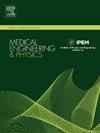Assessment of pre- and post-operative gait dynamics in total knee arthroplasty by a wearable capture system
IF 2.3
4区 医学
Q3 ENGINEERING, BIOMEDICAL
引用次数: 0
Abstract
Background
Walking function reconstruction is suboptimal after total knee arthroplasty. However, a comprehensive investigation of kinematic and kinetic parameters before and after total knee arthroplasty is lacking. This study aimed to quantitatively compare the differences in gait parameters before and after total knee arthroplasty with those of healthy control group.
Methods
This study utilized a wearable capture system to obtain gait parameters from pre- operative and one-year post- operative patients, as well as from the healthy control group. The parameters included walking speed, the stance phase percentage during the gait cycle, knee flexion angle, center of pressure trajectory, vertical ground reaction force, and its moment on the coronal plane of the knee joint.
Results
Post-total knee arthroplasty patients presented an averaged 12.5 % improvement in walking speed and an averaged 19.75 % increasement in the maximum knee flexion angle during the gait cycle, although both were still lower than those of the healthy control group. During the stance phase, the vertical ground reaction force exhibited a less pronounced double-hump feature, and compared to preoperative levels, the peak of the coronal plane moment of the knee was reduced by approximately half.
Conclusion
One-year post- total knee arthroplasty patients exhibited improved walking function compared to preoperative levels, but a gap remained compared to healthy control group. Additionally, preoperative gait abnormalities persisted postoperatively.
用可穿戴捕获系统评估全膝关节置换术前后的步态动力学
背景:全膝关节置换术后行走功能重建不理想。然而,缺乏对全膝关节置换术前后运动学和动力学参数的全面研究。本研究旨在定量比较全膝关节置换术前后与健康对照组步态参数的差异。方法采用可穿戴式采集系统采集术前、术后1年患者及健康对照组的步态参数。参数包括行走速度、步态周期中站立相位百分比、膝关节屈伸角度、压力轨迹中心、垂直地面反作用力及其在膝关节冠状面上的力矩。结果全膝关节置换术后患者步行速度平均提高12.5%,步态周期内最大膝关节屈曲角度平均提高19.75%,但仍低于健康对照组。在站立阶段,垂直地面反作用力表现出不太明显的双驼峰特征,与术前水平相比,膝关节冠状面力矩峰值减少了约一半。结论:与术前相比,全膝关节置换术后1年患者的行走功能有所改善,但与健康对照组相比仍有差距。此外,术前步态异常在术后持续存在。
本文章由计算机程序翻译,如有差异,请以英文原文为准。
求助全文
约1分钟内获得全文
求助全文
来源期刊

Medical Engineering & Physics
工程技术-工程:生物医学
CiteScore
4.30
自引率
4.50%
发文量
172
审稿时长
3.0 months
期刊介绍:
Medical Engineering & Physics provides a forum for the publication of the latest developments in biomedical engineering, and reflects the essential multidisciplinary nature of the subject. The journal publishes in-depth critical reviews, scientific papers and technical notes. Our focus encompasses the application of the basic principles of physics and engineering to the development of medical devices and technology, with the ultimate aim of producing improvements in the quality of health care.Topics covered include biomechanics, biomaterials, mechanobiology, rehabilitation engineering, biomedical signal processing and medical device development. Medical Engineering & Physics aims to keep both engineers and clinicians abreast of the latest applications of technology to health care.
 求助内容:
求助内容: 应助结果提醒方式:
应助结果提醒方式:


